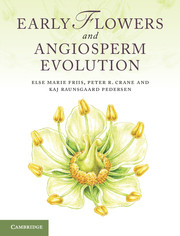Book contents
- Frontmatter
- Contents
- Preface
- 1 Introduction to angiosperms
- 2 The nature of the angiosperm fossil record
- 3 The environmental context of early angiosperm evolution
- 4 Stratigraphic framework and key areas for Cretaceous angiosperms
- 5 Angiosperms in context: extant and fossil seed plants
- 6 Origin and age of angiosperms
- 7 Phylogenetic framework and the assignment of fossils to extant groups
- 8 Fossils near the base of the angiosperm tree
- 9 Early fossil angiosperms of uncertain relationships
- 10 Early fossils of eumagnoliids
- 11 Fossils of monocots
- 12 Fossils of eudicots: early-diverging groups
- 13 Fossils of core eudicots: basal lineages
- 14 Fossils of core eudicots: rosids
- 15 Early fossils of eudicots: asterids
- 16 Patterns of structural diversification in angiosperm reproductive organs
- 17 History and evolution of pollination in angiosperms
- 18 History and evolution of dispersal in angiosperms
- 19 Vegetational context of early angiosperm diversification
- 20 The accumulation of angiosperm diversity
- References
- Index
12 - Fossils of eudicots: early-diverging groups
Published online by Cambridge University Press: 07 September 2011
- Frontmatter
- Contents
- Preface
- 1 Introduction to angiosperms
- 2 The nature of the angiosperm fossil record
- 3 The environmental context of early angiosperm evolution
- 4 Stratigraphic framework and key areas for Cretaceous angiosperms
- 5 Angiosperms in context: extant and fossil seed plants
- 6 Origin and age of angiosperms
- 7 Phylogenetic framework and the assignment of fossils to extant groups
- 8 Fossils near the base of the angiosperm tree
- 9 Early fossil angiosperms of uncertain relationships
- 10 Early fossils of eumagnoliids
- 11 Fossils of monocots
- 12 Fossils of eudicots: early-diverging groups
- 13 Fossils of core eudicots: basal lineages
- 14 Fossils of core eudicots: rosids
- 15 Early fossils of eudicots: asterids
- 16 Patterns of structural diversification in angiosperm reproductive organs
- 17 History and evolution of pollination in angiosperms
- 18 History and evolution of dispersal in angiosperms
- 19 Vegetational context of early angiosperm diversification
- 20 The accumulation of angiosperm diversity
- References
- Index
Summary
Eudicots are an important and well-supported monophyletic group of angiosperms. The clade includes almost all dicotyledons; the only groups excluded are eumagnoliids and those dicots at the ANITA grade plus Chloranthaceae and Ceratophyllum. Eudicots are therefore broadly equivalent to all dicot lineages except the Magnoliidae sensu Takhtajan (1980) (Chapter 7). The term eudicotyledons, or eudicots, was introduced to recognise the monophyletic status of this major group (Doyle and Hotton, 1991), and has been widely accepted in subsequent works. Earlier studies referred to eudicots as non-magnoliid dicots (Walker and Doyle, 1975; Crane, 1989) or tricolpates (Donoghue and Doyle, 1989b; Judd and Olmstead, 2004). The term tricolpates refers to the tricolpate aperture configuration, which is characteristic of the pollen of many early-diverging eudicots. While many eudicots have pollen with other aperture configurations, almost all are based on the triaperturate ground plan (Doyle and Hotton, 1991).
Eudicots are extremely diverse, and exhibit an almost bewildering breadth of morphological and ecological variation. The group contains about three-quarters of all extant angiosperm species (Magallón et al., 1999). The fossil record of eudicots is extensive and informative about their evolutionary history. In this chapter we provide a brief outline of eudicot classification and the early fossil record of the group. We then focus on those lineages that diverged at an early stage from the line that gave rise to the bulk of eudicot species. We emphasise particularly the Cretaceous fossil record, and those taxa that can be recognised based on fossil flowers or other reproductive organs.
- Type
- Chapter
- Information
- Early Flowers and Angiosperm Evolution , pp. 275 - 310Publisher: Cambridge University PressPrint publication year: 2011

